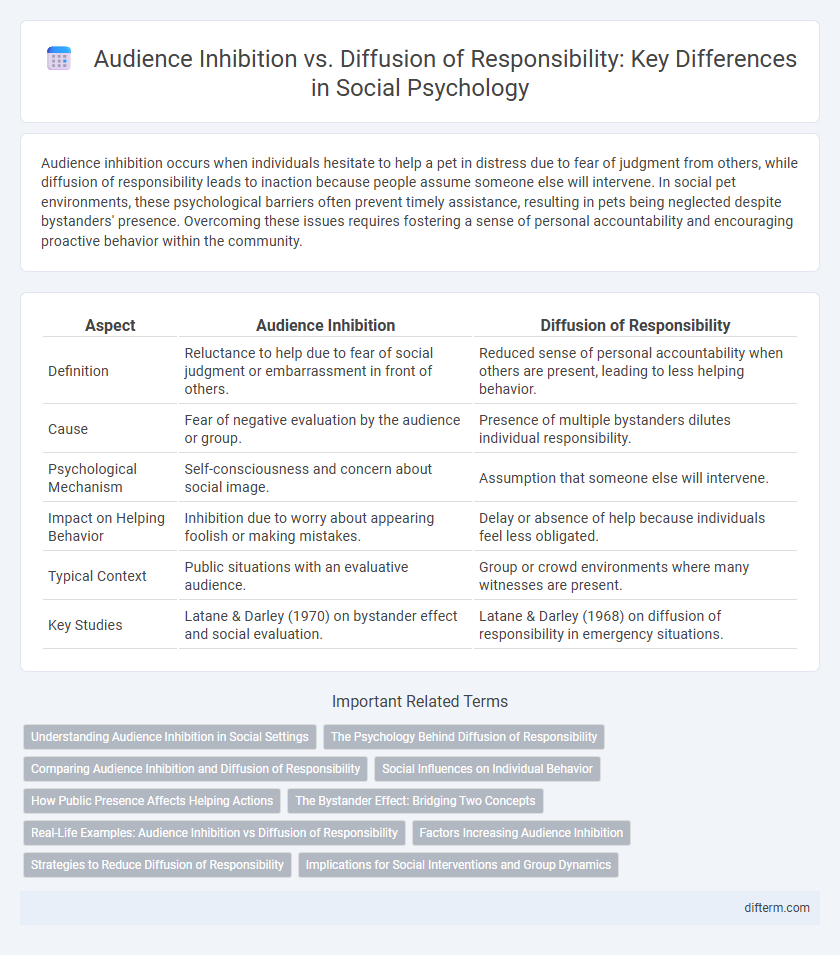Audience inhibition occurs when individuals hesitate to help a pet in distress due to fear of judgment from others, while diffusion of responsibility leads to inaction because people assume someone else will intervene. In social pet environments, these psychological barriers often prevent timely assistance, resulting in pets being neglected despite bystanders' presence. Overcoming these issues requires fostering a sense of personal accountability and encouraging proactive behavior within the community.
Table of Comparison
| Aspect | Audience Inhibition | Diffusion of Responsibility |
|---|---|---|
| Definition | Reluctance to help due to fear of social judgment or embarrassment in front of others. | Reduced sense of personal accountability when others are present, leading to less helping behavior. |
| Cause | Fear of negative evaluation by the audience or group. | Presence of multiple bystanders dilutes individual responsibility. |
| Psychological Mechanism | Self-consciousness and concern about social image. | Assumption that someone else will intervene. |
| Impact on Helping Behavior | Inhibition due to worry about appearing foolish or making mistakes. | Delay or absence of help because individuals feel less obligated. |
| Typical Context | Public situations with an evaluative audience. | Group or crowd environments where many witnesses are present. |
| Key Studies | Latane & Darley (1970) on bystander effect and social evaluation. | Latane & Darley (1968) on diffusion of responsibility in emergency situations. |
Understanding Audience Inhibition in Social Settings
Audience inhibition occurs when individuals withhold helping behavior in social settings due to fear of judgment or embarrassment from bystanders. This psychological barrier contrasts with diffusion of responsibility, where individuals feel less compelled to act because others are present. Understanding audience inhibition involves recognizing how social anxiety and self-consciousness influence decision-making in emergency or public situations.
The Psychology Behind Diffusion of Responsibility
Diffusion of responsibility occurs when individuals in a group feel less personal accountability for actions, often leading to decreased intervention in emergencies. This psychological phenomenon contrasts audience inhibition, where fear of judgment restrains people from helping. Understanding diffusion of responsibility highlights how group size and perceived shared duty diminish individual motivation to act.
Comparing Audience Inhibition and Diffusion of Responsibility
Audience inhibition occurs when individuals hesitate to intervene in emergencies due to fear of judgment or embarrassment by onlookers, whereas diffusion of responsibility refers to the decreased sense of personal accountability experienced when multiple witnesses are present. Both phenomena contribute to the bystander effect, but audience inhibition emphasizes social evaluation concerns, while diffusion of responsibility centers on the distribution of obligation across the group. Understanding these differences is crucial for developing strategies to encourage active intervention in social situations.
Social Influences on Individual Behavior
Audience inhibition occurs when individuals refrain from helping due to fear of negative evaluation by others, while diffusion of responsibility involves a diminished sense of personal accountability in the presence of a crowd. Social influences on individual behavior intensify these effects, as group dynamics shape decision-making processes and reduce intervention likelihood. Research in social psychology demonstrates that awareness of these mechanisms can enhance strategies to promote prosocial actions in public settings.
How Public Presence Affects Helping Actions
Public presence often intensifies audience inhibition, causing individuals to hesitate in offering help due to fear of judgment or making mistakes. Diffusion of responsibility increases when more bystanders are present, as individuals feel less personal obligation to intervene. Consequently, the combination of audience inhibition and diffusion of responsibility can significantly reduce the likelihood of immediate helping behaviors in emergency situations.
The Bystander Effect: Bridging Two Concepts
The bystander effect illustrates how audience inhibition and diffusion of responsibility interplay to reduce intervention in emergencies. Audience inhibition occurs when individuals hesitate to act due to fear of judgment, while diffusion of responsibility involves the perceived shared accountability among witnesses. Understanding this dynamic clarifies why people often remain passive despite witnessing critical situations, highlighting the psychological barriers to helping behavior.
Real-Life Examples: Audience Inhibition vs Diffusion of Responsibility
Audience inhibition occurs when individuals hesitate to intervene in emergencies due to fear of judgment, such as a bystander refraining from helping a person who collapsed at a busy subway station. Diffusion of responsibility happens when multiple witnesses assume others will take action, exemplified by the infamous Kitty Genovese case where numerous neighbors heard her attack but no one immediately called for help. Understanding these social psychological phenomena through real-life incidents highlights barriers to prosocial behavior in group settings.
Factors Increasing Audience Inhibition
Factors increasing audience inhibition include the presence of a large number of bystanders, which triggers self-consciousness and fear of negative evaluation. Ambiguity in the situation also heightens audience inhibition, leading individuals to doubt their ability to correctly interpret or respond. Increased perceived personal accountability and social norms discouraging intervention further amplify the reluctance to act in front of others.
Strategies to Reduce Diffusion of Responsibility
To reduce diffusion of responsibility in social situations, clearly assigning specific roles or tasks enhances individual accountability and encourages proactive behavior. Implementing direct requests for assistance or intervention increases the likelihood of personal involvement by minimizing ambiguity in group settings. Promoting awareness of the diffusion phenomenon through education fosters critical self-reflection and collective responsibility among audience members.
Implications for Social Interventions and Group Dynamics
Audience inhibition reduces individuals' likelihood to intervene in emergencies due to fear of social judgment, whereas diffusion of responsibility disperses accountability among group members, both hindering proactive helping behaviors. Social interventions must incorporate strategies such as anonymous reporting and clearly assigned roles to counteract these psychological barriers and promote accountability in groups. Understanding these dynamics enhances group cohesion and effectiveness by fostering environments where individuals feel empowered to act without fear of negative evaluation or ambiguity in responsibility.
audience inhibition vs diffusion of responsibility Infographic

 difterm.com
difterm.com